
The Very Small Array
A major project undertaken by the Receiver Group at JBO has been to design
and build the 30 Ghz receivers required for the Very Small Array, which is
installed at the Observatory on Mount Teide, Tenerife. Observations at such
high frequencies are not practical in the UK due to the amount of water vapour
present near ground level in our atmosphere; hence the site on Tenerife at a
height of 2.5 km is far better.
The receivers, with their horn antennas will form an aperture synthesis array
to give the resolution of a much larger system - defined by the size of the
array - but capable of simultaneously observing a much larger area of the sky
than a single large antenna.
The VSA is being used to make exceedingly sensitive measurements of the Cosmic
Microwave Background to learn about the early Universe.
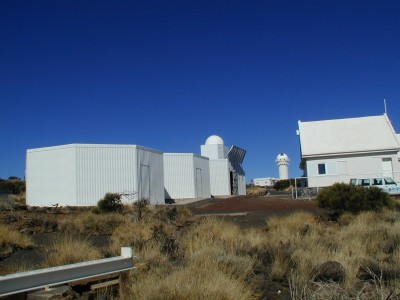
The site of the Experiment enclosure and control building seen from the south east
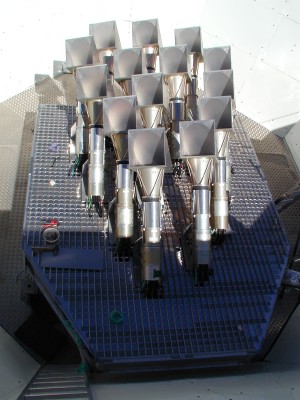
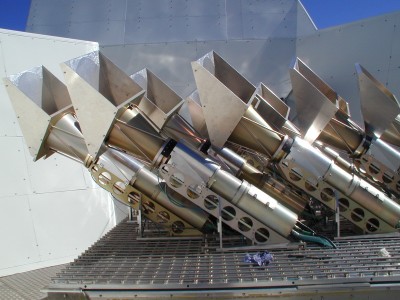
Current configuration of Array
viewed from above the table and from the west side of the table
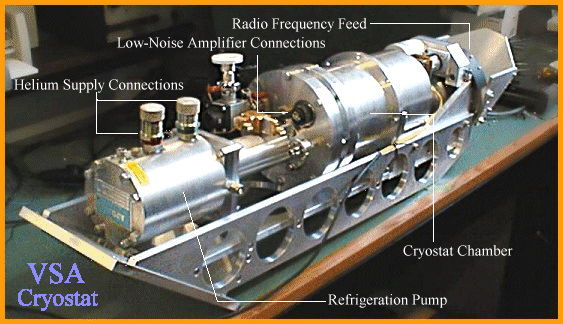
Receiver mounted in it's support cradle
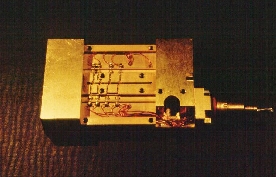
30 Ghz Low Noise Amplifier
The broad-band 30 Ghz low noise amplifers have noise temperature around 15K
and are based on a design originated by Marian Pospieszalski at the National
Radio Astronomy Observatory (NRAO) in the USA.
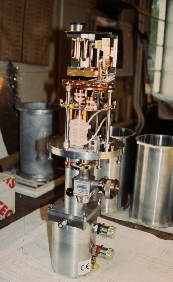
30 Ghz Receiver System
The receiver and part of the feed horn is mounted within a cryostat cooled to
approximatly 15K by the use of a compressed helium refrigeration system.
The system noise temperature of the VSA Receivers is of order 30K which is a
factor of two better than the earlier generation receivers currently in use
on Tenerife.
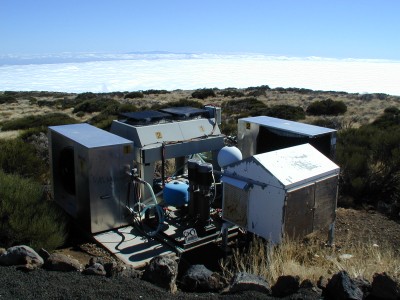
Refrigeration equipment used to cool all receivers
Current Status
Since October 2000 the telescope has been performing regular observations of the
three initial VSA fields using all 14 receivers in the main array and both source
subtraction antennas. Analysis of the data is being performed separately by Jodrell
Bank Observatory, Institute de Astrofísica and Cavendish Laboratories. The final
two receivers were delivered in December 2000 and replaced existing under-performing
receivers in the main array. The opportunity was taken to change the array to
a compact configuration at this time, to produce the required sensitivity level
in a more reasonable, shorter, observing time. Some outstanding construction work
was also completed and the system made ready to survive the ravages of a mountain
winter at a height of 2400m. During late February and early March the two spare
receivers were improved and returned to the island. These took part in the large
horn tests held during the Summer. September saw a massive technical effort on
Tenerife to convert the compact array with small horns to an extended array with
the recently constructed larger horns. This involved the removal of every receiver
from the main table, separation of horn from receiver and the fitting of new larger
horns. Since all receivers would at some point be available for maintenance during
this process, we took the opportunity to cryogenically service as many as possible.
Much preparation was required to create an indoor laboratory suitable for a technician
to dismantle such delicate instruments in a relatively clean and dust free environment.
All specialized service tools and spares were shipped well ahead of time to ensure
arrival on site before technical effort arrived. Several JBO technicians were
involved at various stages, overlapping with each other to achieve the desired
spread of knowledge and capability whilst leaving some effort to keep MERLIN running.
The New York twin towers disaster occurred part way through these visits and did
much to disrupt air travel for the unlucky few. Delays were inevitable, along
with lost and damaged baggage. Despite this spirits remained high and the job
was completed in time to allow the receivers to be re-mounted and cooled whilst
we were still on site to supervise. In spite of needing to turn off all receivers
and cooling plant to carry our this maintenance, all returned to normal after
the service, a compliment to good design and our continued hard work. Some receivers
remain to be serviced but, generally these are the later units and have only operated
for a small number of hours. These will be examined during our routine visits
over the next year.
February 2002
As part of our routine maintenance schedule, two JBO staff attended site during Feb2002. A variety of tasks were undertaken to maintain the high level of reliability already achieved with the experiment.

Work adjacent to the source subtraction enclosure on the spare Edwards E2M28 Vacuum pump.

White APD helium compressors being inspected for coolant leaks after adsorber servicing

Cable and coolant tube tidying after final compressor inspection.

The source subtraction helium compressor being examined to locate a small oil leak.

Cabling to source subtraction receiver being secured

A large bore flexible hose being fitted to the system main array.

Operation of air blast fans being evaluated within cooling compound.

Chiller housing being replaced after operational check.

|
Return to the Jodrell Bank Home page
|
Home |
U.Man |
PPARC |
MERLIN |
VLBI |
Search |
Feedback














